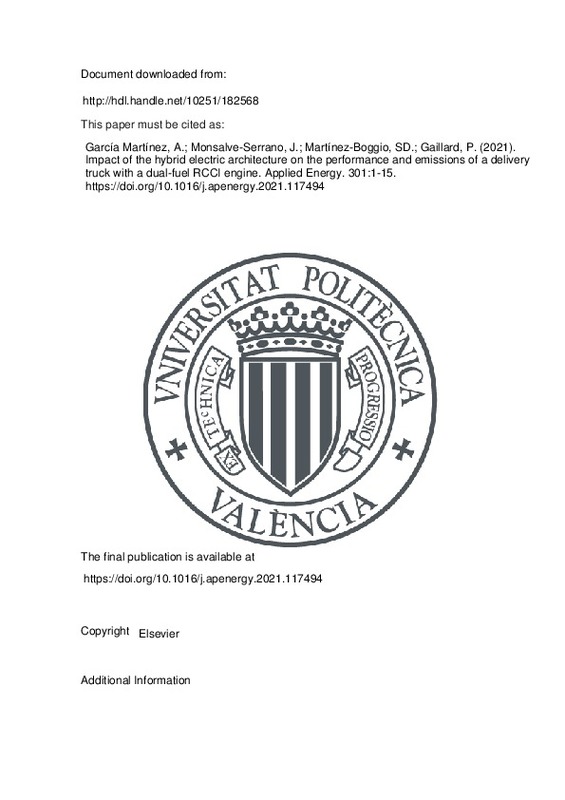JavaScript is disabled for your browser. Some features of this site may not work without it.
Buscar en RiuNet
Listar
Mi cuenta
Estadísticas
Ayuda RiuNet
Admin. UPV
Impact of the hybrid electric architecture on the performance and emissions of a delivery truck with a dual-fuel RCCI engine
Mostrar el registro sencillo del ítem
Ficheros en el ítem
| dc.contributor.author | García Martínez, Antonio
|
es_ES |
| dc.contributor.author | Monsalve-Serrano, Javier
|
es_ES |
| dc.contributor.author | Martínez-Boggio, Santiago Daniel
|
es_ES |
| dc.contributor.author | Gaillard, Patrick
|
es_ES |
| dc.date.accessioned | 2022-05-12T18:06:39Z | |
| dc.date.available | 2022-05-12T18:06:39Z | |
| dc.date.issued | 2021-11-01 | es_ES |
| dc.identifier.issn | 0306-2619 | es_ES |
| dc.identifier.uri | http://hdl.handle.net/10251/182568 | |
| dc.description.abstract | [EN] Reactivity controlled compression ignition combustion showed great advantages in terms of NOx and soot emissions reduction, leading to virtually zero emissions. However, the average brake thermal efficiency of this concept is like that found with conventional diesel operation. The powertrain electrification using electric motors and battery packages appears as a potential solution to reduce the CO2 emissions. For this reason, several solutions for the powertrain electrification can be found currently in the market as the parallel, series and power split powertrain architectures. The aim of this work is to evaluate the hybrid architecture impact on the fuel consumption and emissions of a delivery truck (Volvo-FL) intended for urban and urban-rural applications. The truck equipped with a reactivity-controlled compression ignition diesel-gasoline engine is evaluated and compared against the conventional diesel case. In addition, to evaluate the impact of new e-fuels on the well-to-wheel CO2 emissions, a synthetic gasoline coming from carbon capture and green electricity is evaluated. The results show that hybridization allows reducing the tank-to-wheel CO2 emissions above 15% with the parallel hybrid set-up. The series and power split architectures show CO2 benefits of 12% with respect to the baseline diesel non-hybrid case. Using synthetic gasoline as low reactivity fuel allows to achieve a 50% well-to-wheel CO2 reduction in the P2 and 70% well-to-wheel CO2 reduction for the series and power split cases due to the higher average gasoline fraction used in the driving cycle | es_ES |
| dc.description.sponsorship | The authors thanks ARAMCO Overseas Company and VOLVO Group Trucks Technology for supporting this research. The authors also acknowledge the Conselleria de Innovacion, Universidades, Ciencia y Sociedad Digital de la Generalitat Valenciana for partially supportingthis research through grant number GV/2020/017. | es_ES |
| dc.language | Inglés | es_ES |
| dc.publisher | Elsevier | es_ES |
| dc.relation.ispartof | Applied Energy | es_ES |
| dc.rights | Reconocimiento - No comercial - Sin obra derivada (by-nc-nd) | es_ES |
| dc.subject | E-Components | es_ES |
| dc.subject | Mild hybrid | es_ES |
| dc.subject | Dual-fuel | es_ES |
| dc.subject | Emissions regulations | es_ES |
| dc.subject | Driving cycles | es_ES |
| dc.subject.classification | MAQUINAS Y MOTORES TERMICOS | es_ES |
| dc.title | Impact of the hybrid electric architecture on the performance and emissions of a delivery truck with a dual-fuel RCCI engine | es_ES |
| dc.type | Artículo | es_ES |
| dc.identifier.doi | 10.1016/j.apenergy.2021.117494 | es_ES |
| dc.relation.projectID | info:eu-repo/grantAgreement/GVA//GV%2F2020%2F017 / | es_ES |
| dc.relation.projectID | info:eu-repo/grantAgreement/GENERALITAT VALENCIANA//GV%2F2020%2F062//POTENCIAL DEL USO DE E-FUELS EN PLANTAS PROPULSIVAS HIBRIDAS COMO VIA DE REDUCCION DE LAS EMISIONES DE CO2 DEL SECTOR TRANSPORTE/ | es_ES |
| dc.rights.accessRights | Abierto | es_ES |
| dc.contributor.affiliation | Universitat Politècnica de València. Departamento de Máquinas y Motores Térmicos - Departament de Màquines i Motors Tèrmics | es_ES |
| dc.description.bibliographicCitation | García Martínez, A.; Monsalve-Serrano, J.; Martínez-Boggio, SD.; Gaillard, P. (2021). Impact of the hybrid electric architecture on the performance and emissions of a delivery truck with a dual-fuel RCCI engine. Applied Energy. 301:1-15. https://doi.org/10.1016/j.apenergy.2021.117494 | es_ES |
| dc.description.accrualMethod | S | es_ES |
| dc.relation.publisherversion | https://doi.org/10.1016/j.apenergy.2021.117494 | es_ES |
| dc.description.upvformatpinicio | 1 | es_ES |
| dc.description.upvformatpfin | 15 | es_ES |
| dc.type.version | info:eu-repo/semantics/publishedVersion | es_ES |
| dc.description.volume | 301 | es_ES |
| dc.relation.pasarela | S\444736 | es_ES |
| dc.contributor.funder | GENERALITAT VALENCIANA | es_ES |







![[Cerrado]](/themes/UPV/images/candado.png)

